List of all Spy Ships in the World
Today in this article you get a List of all Spy Ships in the World ( Only Spy Ship or Surveillance Ships ) and we will give you full information related to Spy Ships All Over the World with Specification and Country names etc… These Names Are in Ascending Orders, not in a series, So, let’s Start.
What is Spy Ship?
A dedicated ship designed to acquire intelligence, typically by sophisticated electronic eavesdropping, is known as a spy ship, surveillance ship, or reconnaissance vessel. Any ship designed to acquire information could be viewed as a spy ship in a broader sense.
Due to their high cost and sophisticated technology requirements, spy ships are typically under the control of a country’s government. They frequently belong to the nation’s navy, though secret services may also control them. Naval trawlers pose as fishing trawlers or other civilian ships that are intended to stay in a certain location for a considerable amount of time. Spy ships are sometimes sometimes referred to as vessels used to conceal spies or special forces.
Here is the List of all Spy Ships in the World
#1. Argentine Navy
1. ARA Narwal Spy Ship
Asterio Wagata was the commander of the ARA Narwal, an Argentinian fishing boat outfitted with ELINT during the Falklands War.
Operational background: On April 29, 1982, British air patrols made their first observation of the ship, which had been tasked with executing ELINT operations with other trawlers while stalking the British navy.
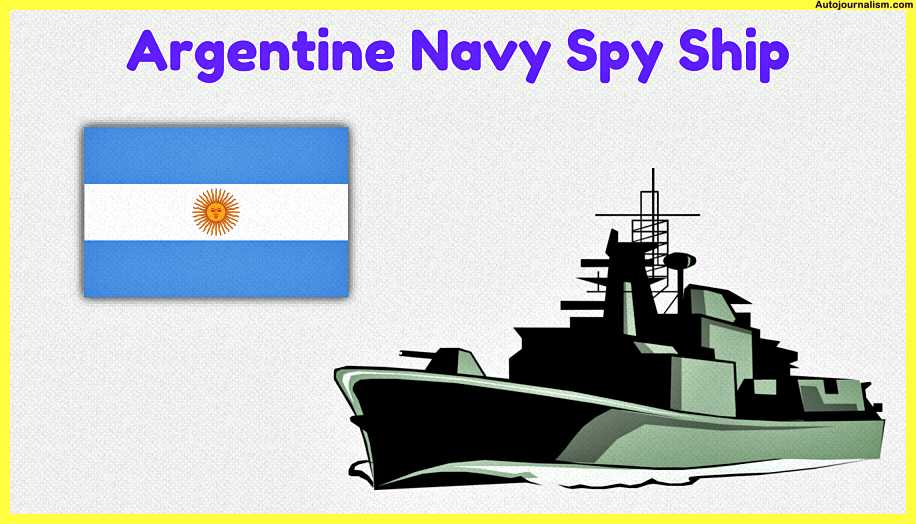
| History | |
|---|---|
| Name | ARA Narwal |
| Owner | Cia Sudamericana de Pesca |
| Builder | Beliard-Murdoch, Ostend |
| Launched | 1962 |
| Identification | IMO number: 5247445 |
| Fate | Sank on 10 May 1982 |
| General characteristics | |
| Tonnage | 1,398 GRT |
| Length | 231 ft (70 m) |
| Beam | 38 ft (12 m) |
| Draught | 17 ft (5.2 m) |
| Installed power | 2330 h.p. |
| Propulsion | 2 x diesel engines |
#2. Chinese Navy
1. Type 813 Spy Ship
The People’s Liberation Army Navy’s Type 813 espionage ship is the first specifically manufactured, domestically developed spy ship to enter service (PLAN).
Midway through the 1970s, there was a critical need for a specialist spy ship for information collecting operations. To expedite the development, it was determined in October 1976 that the newly built spy ship would use the same hull as the Type 645 oceanographic research ship. Design work was started in August 1977 by the 2nd Directorate of the 708th Institute of China State Shipbuilding Corporation, now more formally known as China Shipbuilding and Oceanic Engineering Design Academy. Construction started in September 1980 after design work was finished that month.
The ship was put into service with the South Sea Fleet and carries a total of 10 sets of reconnaissance equipment. The ship is made to resist storms with winds of scale 12. The ship was first known as Xiangyanghong 21 but was subsequently renamed, Neptune. A Type 815A spy ship with the same name, Neptune, took its place when the ship was handed to the Chinese Coast Guard and given the pennant number 3469.
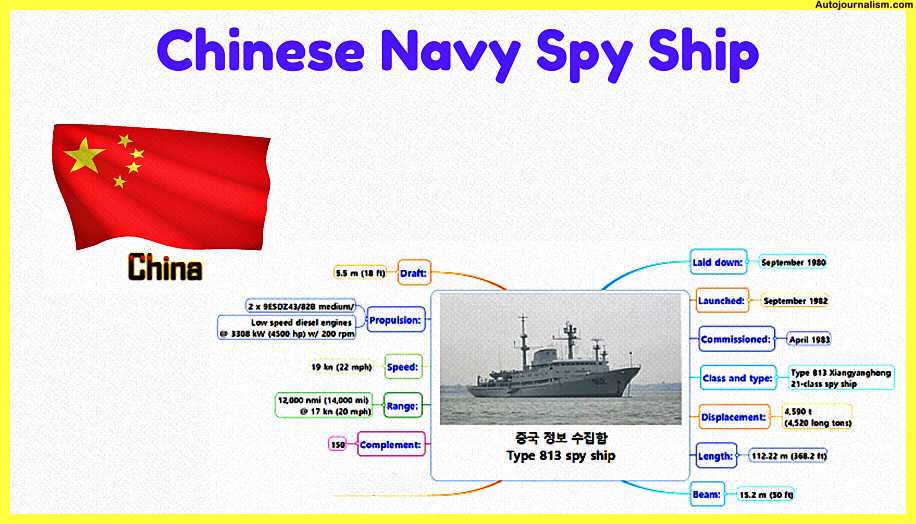
| History | |
|---|---|
| Name | Neptune (852) |
| Builder | Hudong-Zhonghua Shipbuilding |
| Laid down | September 1980 |
| Launched | September 1982 |
| Commissioned | April 1983 |
| General characteristics | |
| Class and type | Type 813 Xiangyanghong 21-class
spy ship |
| Displacement | 4,590 t (4,520 long tons) |
| Length | 112.22 m (368.2 ft) |
| Beam | 15.2 m (50 ft) |
| Draft | 5.5 m (18 ft) |
| Propulsion | 2 x 9ESDZ43/82B
medium/low speed diesel engines @ 3308 kW (4500 hp) w/ 200 rpm |
| Speed | 19 kn (22 mph) |
| Range | 12,000 nmi (14,000 mi) @ 17 kn
(20 mph) |
| Complement | 150 |
2. Type 814A spy ship Spy Ship
Spy ship of type 814A with NATO reporting name Dadie (meaning Big Spy) is a type of spy ship used by the People’s Liberation Army Navy in China as of 2014. (PLAN). Four ships were initially intended, but only one was ultimately built since newer designs became available.
Following the failure of the previously canceled Type 812, PLAN initially requested four spy ships to address its immediate requirements. PLAN suggested using the Type 635C hydrographic survey ship’s hull to expedite the program. The ship’s design was entrusted to the 1st Directorate of the 708th Institute of the China State Shipbuilding Corporation, presently more formally known as the China Shipbuilding and Oceanic Engineering Design Academy.
But once the design was finished, it became clear that it couldn’t satisfy the demands made by PLAN during the design review. PLAN ordered the design to be revised to 1500 tons and given the Type 814 designation on March 25, 1980. The 708th Institute finished the revision on June 30, 1980. However, because of the significant revisions made by PLAN, it was once more made clear during the design review that the updated design was unable to effectively satisfy the new PLAN criteria. The ship’s designer suggested extending it by increasing the displacement from 1500 tons to 1800 tons by 20%. After the suggestion was approved, the modification was finished in February 1982, and the design was finished in August 1982.
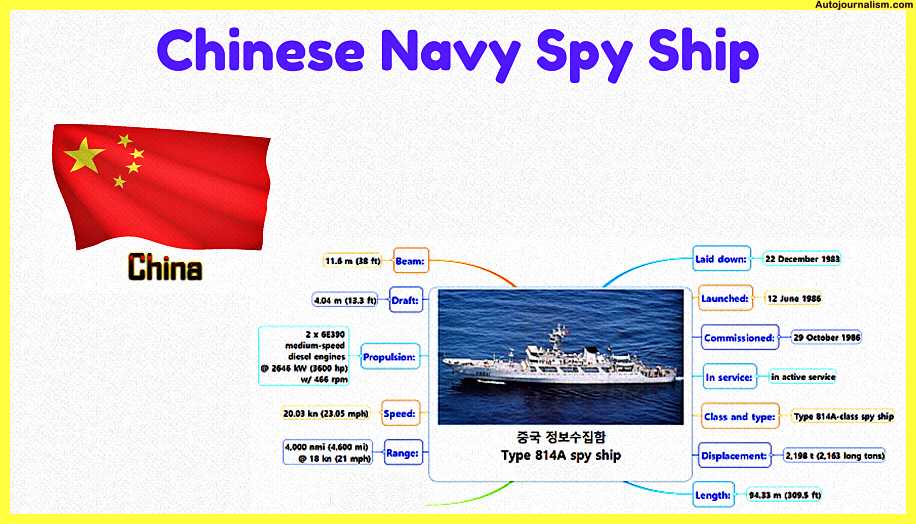
| History | |
|---|---|
| Name | Bei-Diao (900) |
| Builder | Hudong-Zhonghua Shipbuilding |
| Laid down | 22 December 1983 |
| Launched | 12 June 1986 |
| Commissioned | 29 October 1986 |
| In service | in active service |
| General characteristics | |
| Class and type | Type 814A spy ship |
| Displacement | 2,198 t (2,163 long tons) |
| Length | 94.33 m (309.5 ft) |
| Beam | 11.6 m (38 ft) |
| Draft | 4.04 m (13.3 ft) |
| Propulsion | 2 x 6E390 medium-speed diesel engines
@ 2646 kW (3600 hp) w/ 466 rpm |
| Speed | 20.03 kn (23.05 mph) |
| Range | 4,000 nmi (4,600 mi) @ 18 kn (21 mph) |
3. Type 815 spy ship Spy Ship
The People’s Liberation Army Navy uses the Type 815 and its derivatives, the Type 815G and Type 815A, as electronic surveillance ships from China (PLAN). NATO refers to the Type 815 espionage ship as the Dongdiao class (which translates to “East Investigation”), while the Type 815G and Type 815A spy ships are referred to as the Dongdiao II class.
Although Type 813 was intended to be the successor to it, Type 815 served alongside it until Type 813 was finally withdrawn from the PLAN, handed to the Chinese Coast Guard, and transformed into PRCCGS 3469 cutter. Dong-Diao, which translates to “East Investigate,” was the previous designation for Type 815.
However once PLAN established a new naming system, the name was later changed to Polaris. The ship had a significant upgrade some years after going into service in the second half of 1999, replacing its parabolic antennae with three large radomes. This class is charged with tracking ballistic missiles in addition to gathering electronic intelligence. A hangar for a helicopter is present. Specification:
- Size (meters): 130
- Draft (m): 6.5 and width (m): 16.4
- 6000 t of displacement
- Speed (20 kt)
- Crew: 250
- Powered by a diesel engine
- 1 twin 37 mm, 2 twin 25 mm of armor

| History | |
|---|---|
| Status | Active |
| General characteristics | |
| Class and type | Dongdiao I / II class |
| Type | Spy ships (AGI) |
| Propulsion | Marine Diesel |
| Sensors and processing systems |
Navigation radar |
| Electronic warfare & decoys |
None |
| Armour | None |
| Aircraft carried | 1 |
| Aviation facilities | Helipad |
4. Yuan Wang-class tracking ship Spy Ship
The People’s Liberation Army Strategic Support Force of the People’s Republic of China employs the Yuan Wang-class (Chinese: lit. “Long View”) for the tracking and support of satellites and intercontinental ballistic missiles (PRC). In contrast to popular belief, the Yuanwang class is actually a collection of unique designs put together under one series and given the same name.
The PLASSF does not publish the particular details for each ship. When fully laden, Yuanwang 1 and Yuanwang 2 are estimated to have a displacement tonnage of over 21,000 tons, a crew of about 470, and a length of roughly 190 meters (620 ft). One Sulzer Ltd. diesel engine, with a top speed of 20 knots (37 km/h), powers them.
Premier Zhou Enlai first suggested the class in 1965, and Mao Zedong personally endorsed it in 1968. Yuanwang 1 and Yuanwang 2, the first two ships of the class, were constructed at the Jiangnan Shipyard in Shanghai and launched on August 31, 1977, and September 1, 1978, respectively. Xu Xueyan [zh] is the general designer of this class. This allowed the PRC to track satellite launches and other objects for the first time that were not over their borders.
The two ships’ initial survey trip took place in May 1980. Yuanwang 1 and Yuanwang 2, which had previously been employed to track the launches of domestic communications satellites, underwent renovations in 1986 so that the PRC could use them to support the launch of foreign satellites.
The class has had two more ships built. On October 20, 1995, Yuanwang 3 was given the green light. On July 18, 1999, China State Shipbuilding Corporation delivered the Yuanwang 4 tracking ship to the China Satellite Launch and Tracking Control General. It had been transformed from the Xiang Yang Hong 10 scientific survey ship that had previously been in use.
At the beginning of 2007, Shanghai hosted the launch of two further Yuanwang-class ships.
Pictures of Yuanwang 6 were made public, and on the Shenzhou 7 mission, both Yuanwang 5 and the freshly commissioned ship were on duty.
The four ships were situated as follows throughout the Shenzhou spacecraft flights:
- Yuanwang 1 in the Yellow Sea
- Yuanwang 2 is about 1500 km (about 900 statute miles) southwest of French Polynesia
- Yuanwang 3 off the Namibian coast
- Yuanwang 4 off the coast of Western Australia in the Indian Ocean
ship list
- Yuan Wang 1 – 1977
- Yuan Wang 2 – 1978
- Yuan Wang 3 – 1995
- Yuan Wang 4 – 1999
- Yuan Wang 5 – 2007
- Yuan Wang 6 – 2007
- Yuan Wang 7 – 2016
- Yuan Wang 21 – Long March 5 transport ship
- Yuan Wang 22 – Long March 5 transport ship
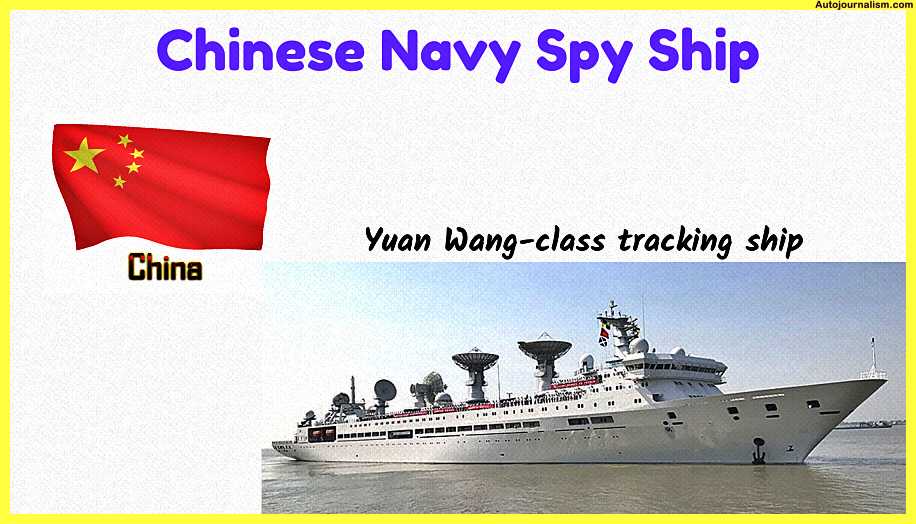
| Class Overview | |
|---|---|
| Builders | Yuan Wang 1 and 2 – Jiangnan Shipyard,
Shanghai / Yuan Wang 3 to 6 – China State Shipbuilding Corporation, Shanghai |
| Operators | People’s Liberation Army Strategic Support Force |
| Preceded by | none |
| Succeeded by | none |
| Completed | 7 |
| Active | 4 |
| Retired | 2, 1 destroyed as target |
| General characteristics | |
| Type | tracking ship |
| Displacement | ~21,000 tons (Yuan Wang 1 and 2: 10,000+ / Yuan Wang 3 and 4 18,000) |
| Length | Yuan Wang 1 – 156.09 m / Yuan Wang 2 – 191 metres; Yuan Wang 3-6 – N/A |
| Beam | Yuan Wang 1 – 20.6 metres / Yuan Wang 2 – 22 metres; Yuan Wang 3-6 – N/A |
| Propulsion | Sulzer Ltd. diesel engine |
| Speed | 20 knots (37 km/h) |
| Complement | Yuan Wang 1 – 200 / Yuan Wang 2 – 470; Yuan Wang 3-6 – N/A |
| Aircraft carried | none, but capable of handling either Super Frelon or Z-8 |
| Aviation facilities | none |
#3. Finnish Navy
Kustaanmiekka (Decommissioned) Spy Ship
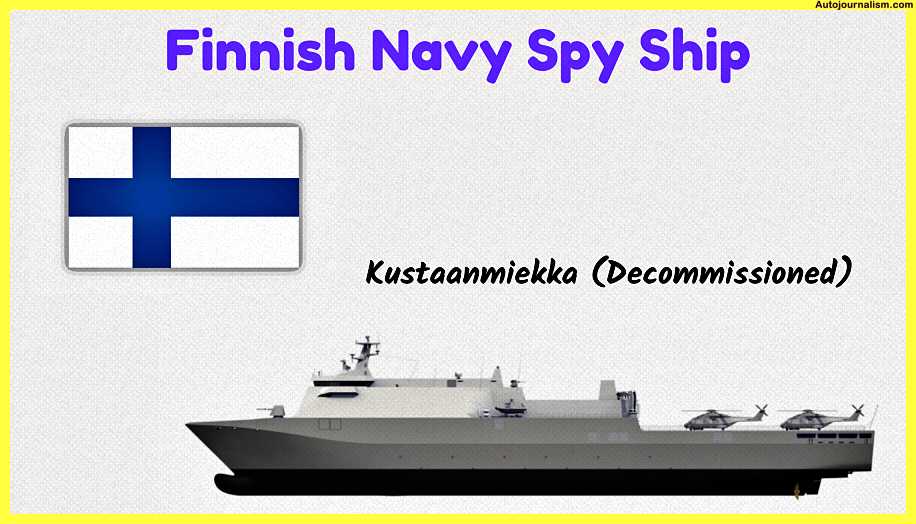
#4. French Navy
Dupuy de Lôme Spy Ship
The Dupuy de Lôme (A759), which bears the name of the engineer Henri Dupuy de Lôme from the 19th century, was inducted into the French Navy’s fleet in April 2006. Its purpose is to gather signals and communications from behind enemy lines. Dupuy de Lôme was built expressly for sea intelligence as part of the MINREM project (Moyen Interarmées Naval de Recherche ElectroMagnétique, “Joint Naval Resources for ElectroMagnetic Research”). Bougainville, the ship she replaced, was not.
Royal Niestern Sander shipyards with yard number 816 in Delfzijl, the Netherlands, developed and constructed the Dupuy de Lôme. The electromagnetic intelligence component of the ship was designed by Thales Naval France. A total of 240 of her 350 operational availability days per year can be spent at sea. Two naval crews each consisting of thirty-three sailors, thirty-three technicians, and, depending on the mission, an optional complement of up to thirty-eight specialists, manage the ship. The Direction du renseignement militaire oversees the activities of the specialized staff.
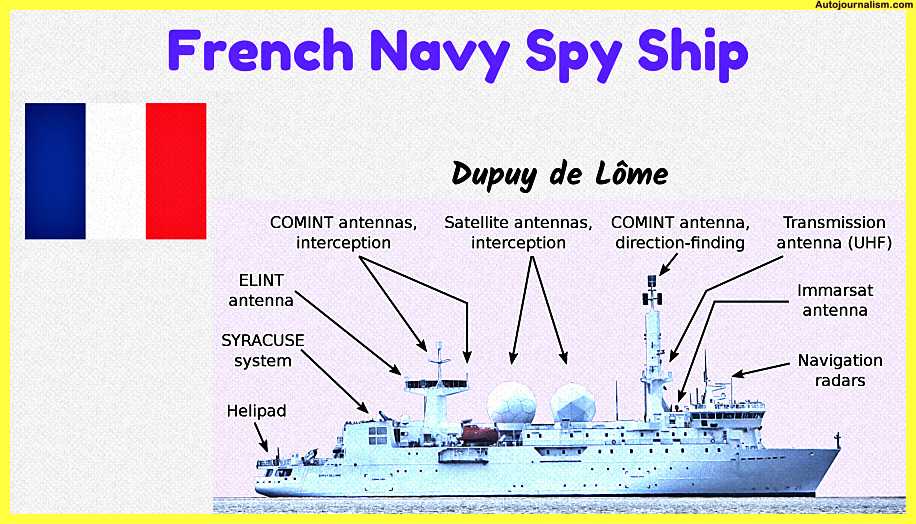
| History | |
|---|---|
| Name | Dupuy de Lôme |
| Namesake | Henri Dupuy de Lôme |
| Launched | 27 March 2004 |
| Commissioned | April 2006 |
| Identification |
|
| Status | In active service |
| General characteristics | |
| Displacement | 3,100 t (3,600 t full load) |
| Length | 101.75 m (333.8 ft) |
| Beam | 15.85 m (52.0 ft) |
| Draught | 4.9 m (16 ft) |
| Propulsion | 2 Mak 9M25 diesels |
| Speed | 16 knots (30 km/h; 18 mph) |
| Range | 6,300 km (3,400 nmi; 3,900 mi) |
| Complement | 8 officers, 16 Warrant officers, 6 quarter-masters, 78 engineers |
| Sensors and processing systems |
2 DRBN38A navigation radars |
| Electronic warfare & decoys |
|
| Armament | 2 × 12.7 mm M2 Browing machine guns |
#5. German Navy
Oste-class fleet service Spy Ship
The German Navy’s Type 423 Oste class of ships are designed specifically as signals intelligence (SIGNINT/ELINT) and reconnaissance vessels. They took the position of the Type 422 class and were given the official designation of “fleet service ships.”
The crew quarters were created in accordance with civil norms, and compared to other German Navy ships, the Oste class provides a lot greater comfort for the crew.
List of ships
| Ship | Pennant number |
Call sign | Launched | Commissioned |
|---|---|---|---|---|
| Oste | A52 | DRHH | 30 July 1988 | |
| Oker | A53 | DRHG | 10 November 1988 | |
| Alster | A50 | DRHF | 14 November 1988 | 5 October 1989 |
The ships were constructed in Flensburg at Flensburger Schiffbau-Gesellschaft.
All of the ships are now stationed in Eckernförde and are part of the 1st Ubootgeschwader, which is based there. The three Type 422 class warships that they replaced were given the same names and pennant numbers for the new vessels. The ship names are occasionally prefixed with II to prevent misunderstanding.
In August 2012, Oker (A53) is said to have been spotted close to the Syrian shore. Later, in February 2017, she was spotted in Greenwich, UK.
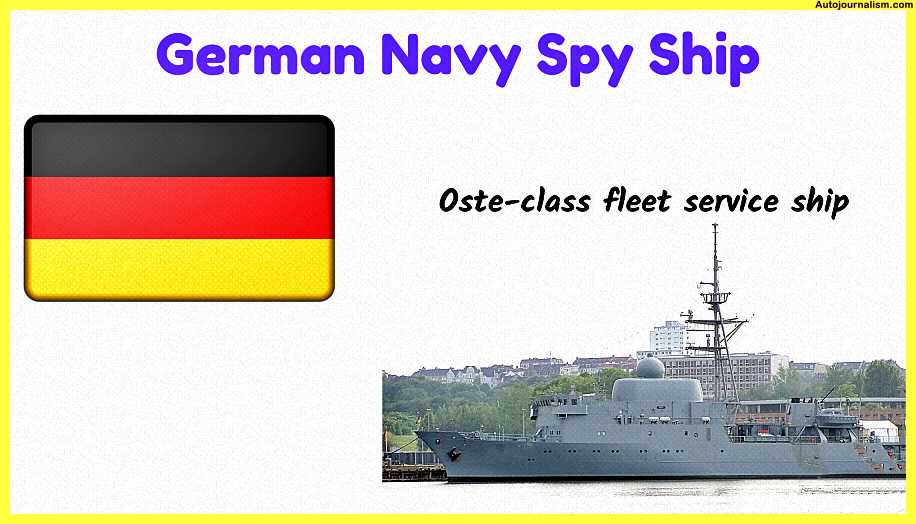
| Class overview | |
|---|---|
| Builders | Flensburger Schiffbau-Gesellschaft, Flensburg |
| Operators | |
| Preceded by | Type 422 class |
| In commission | 1988– |
| Completed | 3 |
| Active | 3 |
| General characteristics | |
| Displacement | 3,200 tonnes |
| Length | 83.5 m (273 ft 11 in) |
| Beam | 14.6 m (47 ft 11 in) |
| Draught | 4.2 m (13 ft 9 in) |
| Propulsion | 2 diesel engines, 3,300 kW (4,400 hp) each |
| Speed | 21 knots (39 km/h) |
| Range | More than 5,000 nautical miles (9,300 km) |
| Complement | 36 + up to 40 mission specialists |
| Sensors and processing systems |
ELINT/COMINT sensors |
| Electronic warfare & decoys |
Electronic countermeasures[specify] |
| Armament | None |
#6. Indian Navy
1. INS Anvesh (A41) Spy Ship
The missile range instrumentation ship INS Anvesh, also known as a “Floating Test Range” (FTR), was created for the Indian Navy and was formerly known as the DRDO Technology Demonstration Vessel. The ship was created as a sea-based platform for India’s ballistic missile defense program by the Defense Research and Development Organization (DRDO) and Cochin Shipyard Limited (CSL). [3] Vik-Sandvik Design India Pvt Ltd (also known as “VSDI”) created the ship’s design.
In August 2015, the DRDO, India’s top defense research, and development organization awarded Cochin Shipyard Limited (CSL) the construction to build the DRDO Technology Demonstration Vessel.
This ship is 118.4 meters long, 20 meters wide, and 7.1 meters deep, and it weighs about 3900 tons of steel.
The vessel’s construction was originally under contract with Bharati Shipyard, but the agreement was terminated due to time overruns imposed by the yard’s precarious financial situation. The Cochin Shipyard ultimately won the bid to carry out this project.

| History | |
|---|---|
| Name | Anvesh |
| Operator |
|
| Builder | Cochin Shipyard Limited |
| Cost | ₹425 crore |
| Laid down | 27 January 2016 |
| Commissioned | Q4 2021 (Expected) |
| Identification | Pennant number: A41 |
| Status | Sea Trials |
| General characteristics | |
| Type | Tracking ship |
| Displacement | 11,300 tonnes (11,122 long tons; 12,456 short tons) |
| Length | 118.40 m (388 ft 5 in) |
| Beam | 20 m (65 ft 7 in) |
| Draught | 7.1 m (23 ft 4 in) |
| Depth | 10.40 m (34 ft 1 in) |
| Installed power |
|
| Propulsion |
|
| Speed | Over 18.5 knots (34.3 km/h; 21.3 mph) |
| Complement | 150 |
| Sensors and processing systems |
LRDE Long-Range Multi-Function Radar |
| Notes | 4 x Ship launch systems for BMD test missiles |
2. INS Dhruv Spy Ship
Hindustan Shipyard Limited in India constructed the research vessel and missile range instrumentation ship known as INS Dhruv (A40) (HSL). The ship was previously solely identified by its designated shipyard yard number, VC-11184.
The ship can gather electronic intelligence and will be used to track satellites and missiles to support India’s anti-ballistic missiles and strategic weapons. The National Technical Research Organization, the Defence Research and Development Organization, and the Indian Navy will all work together to run it. The duration of a ship’s development has mostly remained a secret, with minimal information in the public realm. Without a formal public launching ceremony, the ship allegedly began sea trials in early 2019 and entered service in October 2020. In the presence of top representatives from the Indian Navy, the Defense Research and Development Organization (DRDO), and the National Technical Research Organization, the ship was formally commissioned on September 10, 2021, in Visakhapatnam (NTRO).
The ship’s mission is to aid in the development of India’s strategic arsenal and ballistic missile defense program. The ship has satellite and missile tracking capabilities. It is also capable of gathering electronic intelligence. The ship’s keel was laid at Hindustan Shipyard Limited on June 30, 2014. It is being constructed as part of a secretive program that is directly supervised by the National Security Advisor and the Prime Minister’s Office, much like the Indian Navy’s Advanced Technology Vessel (ATV) program. The ship began port trials in July 2018 and was scheduled to go through sea trials by the year’s end. Sea trials were still underway as of March 2019.
The ship was discretely handed over to the Indian Navy in October 2020, with the official induction taking place in the first half of 2021.
The ship was created in India by Vik Sandvik Design India for about 1,500 crores (about 20 billion or US$270 million in 2020).
It can reach a speed of 21 knots and has a displacement of more than 10,000 tonnes. It is 175 meters long, 22 meters wide, and 6 meters deep. It is powered by three 1200 kilowatt auxiliary generators and two imported 9,000 kilowatts combined diesel and diesel (CODAD) configuration engines.
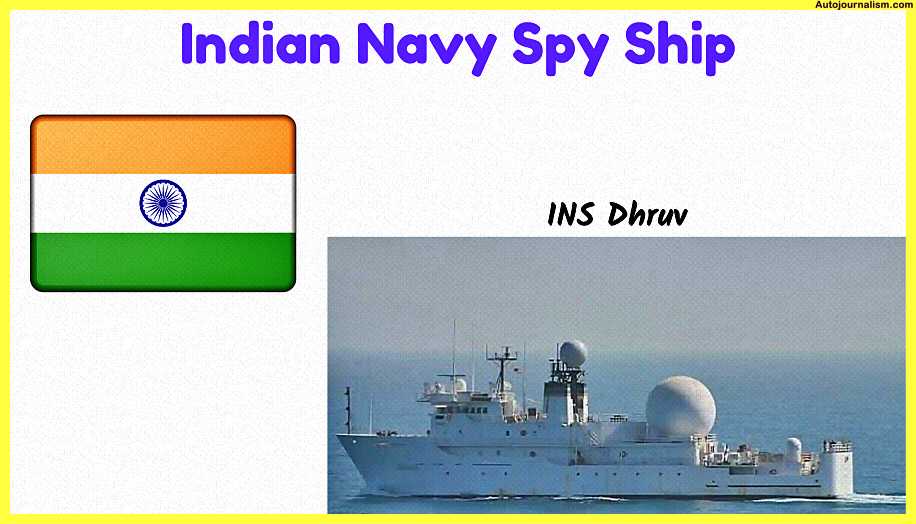
| History | |
|---|---|
| Name | INS Dhruv |
| Operator | Jointly operated by the Indian Navy
National Technical Research Organisation Defense Research and Development Organisation |
| Builder | Hindustan Shipyard Limited |
| Cost | ₹1,500 crore |
| Laid down | 30 June 2014 |
| Acquired | 31 October 2020 |
| Commissioned | 10 September 2021 |
| Identification | Pennant number: A40 |
| Status | In Service |
| General characteristics | |
| Type | Ocean surveillance and missile tracking ship |
| Displacement | 15,000 t (15,000 long tons; 17,000 short tons) |
| Length | 175 m (574 ft) |
| Beam | 22 m (72 ft) |
| Draught | 6 m (20 ft) |
| Propulsion |
|
| Speed | 21 kn (39 km/h; 24 mph) |
| Complement | 300 |
| Sensors and processing systems |
|
| Aircraft carried | 1 × helicopter |
#7 Italian Navy
Elettra Spy Ship
A SIGINT vessel for the Italian Navy named Elettra (A 5340) is known as the “Nuova Unità Polivalente di Supporto” (NUPS).
The ship’s platform was modified from the RV Alliance created for NATO in order to conduct research and surveillance operations.
She is the first surface vessel in the world to use this sort of engine as part of her propulsion system, which is based on two permanent magnet electric engines. High reliability, high efficiency, low maintenance, and low undersea radiated noise are this propulsion system’s key attributes.
The ship is equipped with:
advanced electronic intelligence equipment, including 27 different electronic and acoustic reconnaissance devices and a submersible ROV with an echo sounder that can launch unmanned aerial vehicles from the back flight deck. Compression chamber only Galeazzi DRASS for 8 people.
| Pennant number |
Hull number |
Owner | Laid Down | Launched | Commissioned | Motto | Note | |
|---|---|---|---|---|---|---|---|---|
| Italian ship Alliance (A 5345) | A 5345 | 921 | NATO operated by Italian Navy |
18 July 1984 | 9 July 1986 | 6 May 1988 | about 50 Billion Lire contract | |
| Ta Kuan | AGS-1601 | 5942 | Taiwan Navy |
October 1993 | 17 December 1994 | 26 September 1995 | about 100 Billion Lire contract | |
| Italian ship Elettra (A 5340) | A 5340 | 6080 | Italian Navy |
March 2000 | 24 July 2002 | 2 April 2003 | Anima i silenzi aerei | About 139 Billion Lire contract |
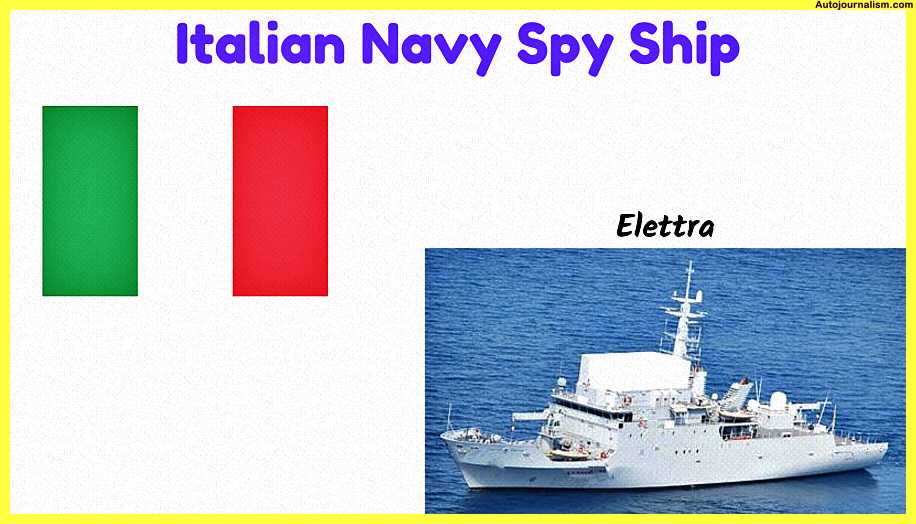
| History | |
|---|---|
| Name | Elettra |
| Ordered | 1999 |
| Builder | Fincantieri – Cantiere Navale del Muggiano (La Spezia) |
| Laid down | 20 January 2001 |
| Launched | 24 July 2002 |
| Commissioned | 2 April 2003 |
| Homeport | La Spezia |
| Identification | Pennant number: A 5340 |
| Motto | Anima i silenzi aerei |
| Status | Active as of 2018 |
| General characteristics | |
| Type | Auxiliary ship |
| Displacement |
|
| Length | 93.5 m (306 ft 9 in) |
| Beam | 15.5 m (50 ft 10 in) |
| Draught | 4.83 m (15 ft 10 in) |
| Propulsion |
(2.200 kW each)
Isotta Fraschini IF V1708T2 (770 kW each)
|
| Speed | 16.5 knots (30.6 km/h; 19.0 mph) |
| Range | 8,000 nmi (15,000 km; 9,200 mi) at 12 knots (22 km/h; 14 mph) |
| Complement |
|
| Sensors and processing systems |
|
| Armament | 2 × OTO Melara KBA 25/80 mm |
| Notes |
|
#8. Royal Norwegian Navy
1. Marjata(1992) Spy Ship
A vessel designed specifically for gathering electronic intelligence, FS Eger (FS Marjata III throughout most of its lifespan) (ELINT).
She is the third vessel to carry the name Marjata.
The first was operating from 1966 to 1975, and the second from 1976 to 1995. The Norwegian Armed Forces have utilized all of these ships for military intelligence operations, with the first two entering service during the Cold War.
One of the most technologically sophisticated ships of her kind in the world, she is owned by the Norwegian Defence Research Establishment but operated by the Norwegian Intelligence Service. Although she was built for operations anywhere in the world, her primary duty is to monitor the Russian Northern fleet’s actions in the Barents Sea. In close proximity to the Russian border, she operates in international seas. The Norwegian Intelligence Service uses Marjata formally as a research vessel.
When the ship’s precise trimming is not crucial, it can still function even with significant portions of its interior submerged. If the ship is subjected to icing or significant volumes of water on deck, the same is true for cargo shift. The ship is additionally outfitted to work for extended periods in arctic waters, but it was also built to perform in other maritime environments. It is thought that operating in polar northern regions can continue without interruption for very long periods of time due to the great stability of the hull and the entire structure’s capacity to tolerate significant amounts of icing.
The ship is described as an intelligence/surveillance vessel. The Eger is also referred to as a spy ship and has participated in numerous operations over the years.
It has an unusual hull shape and is a Ramform-style ship. The ship’s hull has a distinctive design with a sharp bow, sinusoidal waterline, dropping rear body, and straight, cut-off stern, which is where the ship is widest. The ship will have an operational metacentric height of around 16 meters due to its extremely wide beam. Marjata is a very steady sensor platform that has been designed with a very low noise profile to prevent interference from the ship’s own systems.

| History | |
|---|---|
| Name | Marjata |
| Owner | Norwegian Defence Research Establishment |
| Operator | Norwegian Intelligence Service |
| Ordered | 1991 |
| Builder | Langsten shipyard, Aker Yards, Tomrefjord, Norway |
| Yard number | 160 |
| Launched | 18 December 1992 |
| Commissioned | 1995 |
| Homeport | Karljohansvern, Horten |
| Identification |
|
| Status | In service |
| General characteristics | |
| Type | Military intelligence ship (ELINT) |
| Displacement | 7,560 tons (full load) |
| Length | 81.5 m (267 ft 5 in) |
| Beam | 40 m (131 ft 3 in) |
| Draught | 6 m (19 ft 8 in) |
| Propulsion | 2 × diesel engines and 2 × gas turbines |
| Speed | 15 knots (28 km/h; 17 mph) |
| Complement | unknown |
| Aviation facilities | Helipad |
2. Marjata(2014) Spy Ship
The parliament placed an order for the FS Marjata, a Norwegian electronic intelligence collecting vessel (ELINT), in 2010. On December 6, 2014, Prime Minister Erna Solberg baptized it. Crew members from the Norwegian Intelligence Service are on board the ship.

It’s the fourth vessel with the name Marjata. The first was in effect from 1966 to 1975, the second from 1976 to 1995, and the third from 1995 to (still operating, but renamed FS Eger). Her predecessor was supposed to be replaced by Marjata, but it was decided to keep both for the same position. Previously known as research ships, the new Marjata is the first ship to formally conduct intelligence operations as well. Her predecessor, FS Eger, has occasionally joined her on missions; these missions are frequently intelligence or spy assignments. Neither helicopters nor weaponry is present on the ship. The ship is 126 meters long and 23.5 meters broad, weighing 5000 tons.
#9. Polish Navy
1. ORP Nawigator Spy Ship
Polish reconnaissance vessel ORP “Nawigator,” tactical number 262, radio-electronic reconnaissance project 863 (NATO code: Modified Moma).
The first in a series, it was created in Poland and constructed at the Northern Shipyard in Gdansk. Its identical twin is the ORP “Hydrograf.” The vessel is a member of the Reconnaissance Ship Group and is assigned to the 3rd Ship Flotilla. To undertake radio-electronic reconnaissance of the Navy, the ship is equipped. It is a ship with unrestricted seaworthiness and extended autonomy that can sail through any body of water on the planet.
The ship participated in a significant Navy exercise known as Reda-83 on May 4–26, 1983. The ship underwent refurbishment and modernization in 2010–2013 and 2018 that included the replacement of 95% of the equipment and assembly, including delivery, installation, and integration of Broadband Recognition Systems and Electronic Support Measures (ESM). These initiatives aim to drastically modernize and extend the ship’s service.
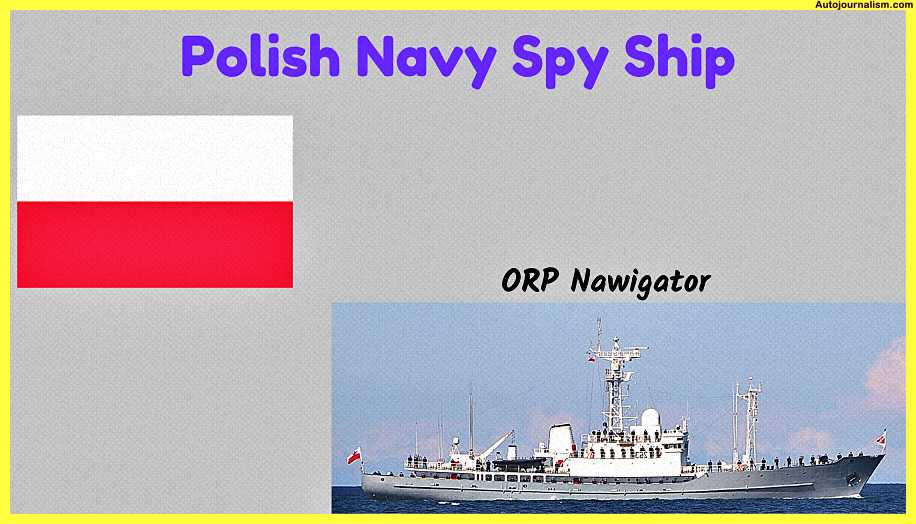
| ORP Navigator (2017) | |
| Project | 863 |
|---|---|
| NATO designation | Modified Moma |
| History | |
| Shipyard | Northern Shipyard , Gdańsk |
| Entry into service | February 17, 1975 |
| The fate of the ship | in duty |
| Tactical and technical data | |
| Displacement | 1,467 t std (1,675 t full) |
| Length | 73,3 m |
| Width | 10,8 m |
| Dipping | 3,6 m |
| Drive | |
| 2 Zgoda-Sulzer diesel engines 1,800 KM (each) | |
| Speed | 17 w. |
| Reception | 7200 Mm |
| Armament | |
| 4 Strzała-2M anti-aircraft missile launchers | |
2. ORP Hydrograf Spy Ship
ORP “Hydrograf” is a Polish reconnaissance vessel with the tactical number 263, radio-electronic reconnaissance project 863, and image reconnaissance project 863.
The second in the series, the ship was created in Poland and constructed at the Northern Shipyard in Gdansk. ORP “Nawigator” is its twin ship. The vessel is a member of the Reconnaissance Ship Group and is assigned to the 3rd Ship Flotilla.
The ship underwent renovation and modernization between the years 2018 and 2020, including the assembly of Electronic Support Measures (ESM), delivery, assembly, and integration of the reconnaissance command system and the receiving-antenna system, assembly of Broadband Reconnaissance Systems, delivery, assembly, and integration of the optoelectronic system, as well as major and dock repairs.
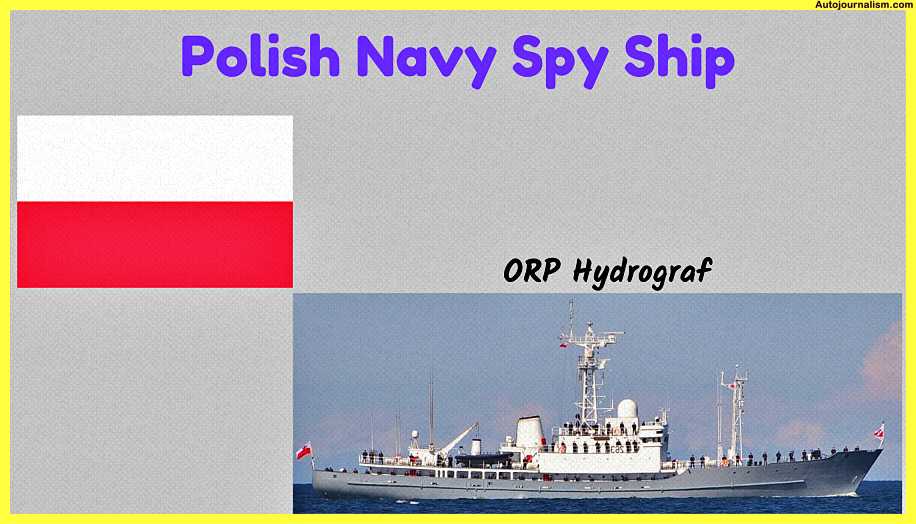
| ORP Hydrograf (2011) | |
| Project | 863 |
|---|---|
| NATO designation | Modified Moma |
| History | |
| Shipyard | Northern Shipyard , Gdańsk |
| Laying down the keel | February 6, 1975 |
| Launching | September 20, 1975 |
| Entry into service | 8 houses in 1976 |
| The fate of the ship | in duty |
| Tactical and technical data | |
| Displacement | 1,467 t std (1,675 t full) |
| Length | 73,3 m |
| Width | 10,8 m |
| Dipping | 3,6 m |
| Drive | |
| 2 Zgoda-Sulzer diesel engines 1,800 KM (each) | |
| Speed | 17 w. |
| Reception | 7200 Mm |
| Armament | |
| 4 Strzała-2M rocket launchers | |
#10. Russian Navy
1. Primor’ye-class surveillance Spy Ship
- SSV-590 Krym
- SSV-591 Kavkaz
Four further ships were retired in the mid-to-late 1990s.

| lass overview | |
|---|---|
| Builders | 61 Kommunara Zavod, Nikolayev, Ukraine |
| Operators | Soviet Navy, Russian Navy |
| Succeeded by | Balzam-class intelligence ship |
| Built | 1969-1973 |
| In commission | 1970 ? – present day |
| Completed | 6 |
| Active | 2 |
| Retired | 4 |
| General characteristics | |
| Type | Intelligence collection ship |
| Displacement | 4,340 tons full load |
| Length | 84.6 m |
| Beam | 14 m |
| Draught | 7.2 m |
| Propulsion | 1 shaft, 2 diesel engines, 2000 hp |
| Speed | 12.5 knots |
2. Balzam-class intelligence Spy Ship
| Name | Hull No. | Builder | Laid down | Launched | Commissioned | Fleet | Status |
|---|---|---|---|---|---|---|---|
| Lira | 516 | Yantar Shipyard, Kaliningrad | 9 February 1980 | Northern Fleet | Decommissioned in 1997 | ||
| Azia | 493 | Yantar Shipyard, Kaliningrad | 13 February 1981 | Pacific Fleet | In reserve | ||
| Pribaltica | 80 | Yantar Shipyard, Kaliningrad | 28 July 1984 | Pacific Fleet | Active | ||
| Belmore | 463 | Yantar Shipyard, Kaliningrad | 7 February 1987 | Northern Fleet | In reserve |
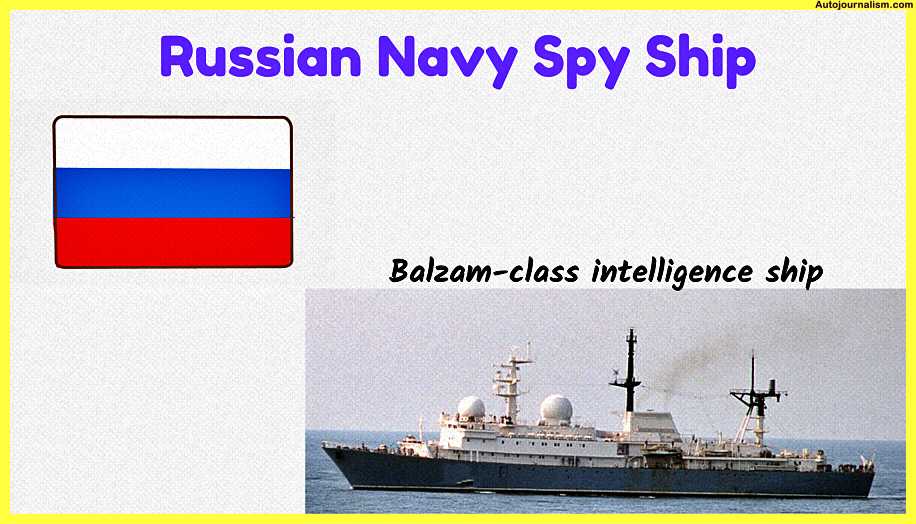
| Class overview | |
|---|---|
| Builders | Yantar Yard Kaliningrad |
| Operators |
|
| Preceded by | Primor’ye-class surveillance ship |
| Succeeded by | Vishnya-class intelligence ship |
| Built | 1980–1986 |
| In commission | 1980–1987 |
| Planned | 4 |
| Completed | 4 |
| Active | 1 |
| Laid up | 2 |
| Retired | 1 |
| General characteristics | |
| Type | intelligence ship |
| Displacement | 4,900 tons full load |
| Length | 105 m (344 ft) |
| Beam | 15.5 m (51 ft) |
| Draught | 5 m (16 ft) |
| Propulsion | 2 shaft diesel 9,000 hp (6,700 kW) |
| Speed | 20 knots (37 km/h) |
| Complement | 220 |
| Sensors and processing systems |
Sonar: MG-349 hull mounted array,
MG-13 underwater communications, MG-7 |
| Electronic warfare & decoys |
Cage Pot I, Twin Wheel, Log Maze |
| Armament | 2 × 4 9K32 Strela-2 positions,
1 × 30 mm AK-630 anti-aircraft gun, 1×7 55 mm MRG-1 grenade launcher |
3. Vishnya-class intelligence Spy Ship
| Name | Hull No. | Laid down | Launched | Commissioned | Fleet | Status | Notes |
|---|---|---|---|---|---|---|---|
| Fedor Golovin (ex-Meridian) |
520 | 14 November 1985 | Baltic Fleet | Active | |||
| Kareliya | 535 | 5 July 1986 | Pacific Fleet | Active | Active in 2021–2022
off Hawaii |
||
| Tavriya | 169 | 17 January 1987 | Northern Fleet | Active | |||
| Priazovye | 201 | 12 June 1987 | Black Sea Fleet | Active | In 2020–2021 deployed
to the Mediterranean Sea |
||
| Kurily | 208 | 16 October 1987 | Pacific Fleet | Active | |||
| Vasiliy Tatishchev (ex-Pelengator) |
231 | 27 November 1987 | 23 July 1988 | Baltic Fleet | Active | In 2021 deployed
to the Red Sea |
|
| Viktor Leonov (ex-Odograf) |
175 | 1988 | Northern Fleet | Active | Active off U.S. and U.K.,
docks in Havana |
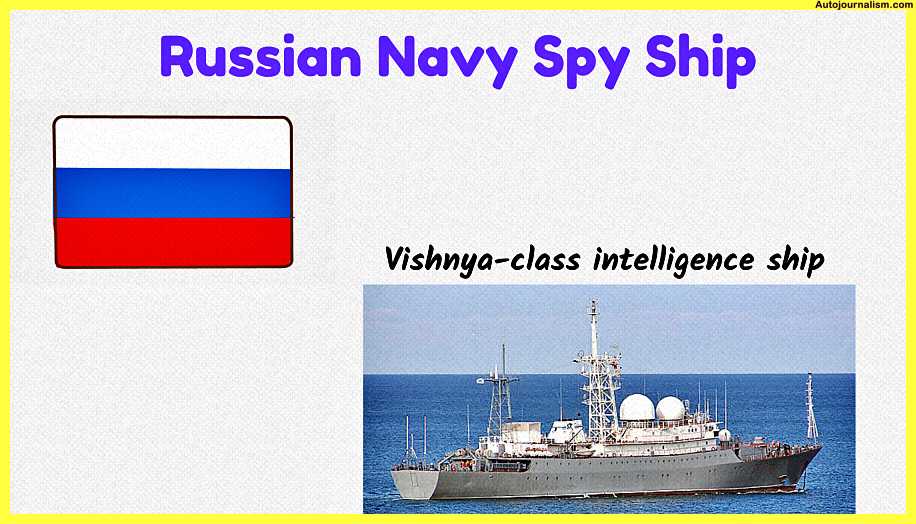
| Class overview | |
|---|---|
| Builders | Stocznia Północna, Gdańsk, Poland |
| Operators |
|
| Preceded by | Balzam class |
| Succeeded by | Yury Ivanov class |
| Planned | 7 |
| Completed | 7 |
| Active | 7 |
| General characteristics | |
| Type | Intelligence collection ship |
| Displacement | 3,470 tons full load |
| Length | 91.5 m (300 ft 2 in) |
| Beam | 14.6 m (47 ft 11 in) |
| Draught | 4.5 m (14 ft 9 in) |
| Propulsion | 2 shafts, 2x Zgoda Sulzer 12AV diesel engines, 4,400 bhp (3,300 kW) |
| Speed | 16 knots |
| Complement | 146 (= 6 passengers) |
| Sensors and processing systems |
Radar: MR-212/201 (Palm Frond) Sonar: MG-349, MGP-303 |
| Electronic warfare & decoys |
Various intercept arrays and radio direction finding equipment |
| Armament |
|
4. Yantar Spy Ship
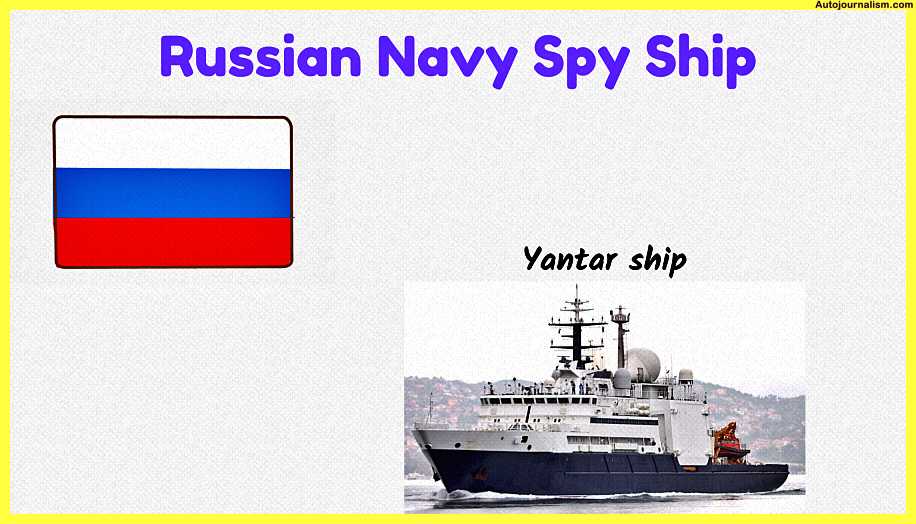
| History | |
|---|---|
| Name | Yantar |
| Builder | Yantar Shipyard |
| Yard number | 01602 |
| Laid down | 8 July 2010 |
| Launched | 5 December 2012 |
| Commissioned | 23 May 2015 |
| Identification |
|
| Status | In service |
| General characteristics | |
| Class and type | Project 22010-class intelligence ship |
| Displacement | 5,736 tons (full load) |
| Length | 107.8 m (354 ft) |
| Beam | 17.2 m (56 ft) |
| Installed power |
|
| Propulsion |
|
| Speed | 15 kn (28 km/h; 17 mph) |
| Range | 8,000 nmi (15,000 km; 9,200 mi) |
| Endurance | 60 days |
| Boats & landing craft carried |
|
| Complement | 60 |
| Aviation facilities | |
Sister ships
Almaz
A sister Project 22010-class ship Almaz is also under construction.
Burilichev
On 5 February 2021, the third ship of the series was reportedly laid down in the Vyborg Shipyard under the name Vice-admiral Burilichev, to honor a former head of the GUGI, Alexey Vitalyevich Burilichev, who died in November 2020 due to coronavirus.
#11. Spanish Navy
Alerta Spy Ship
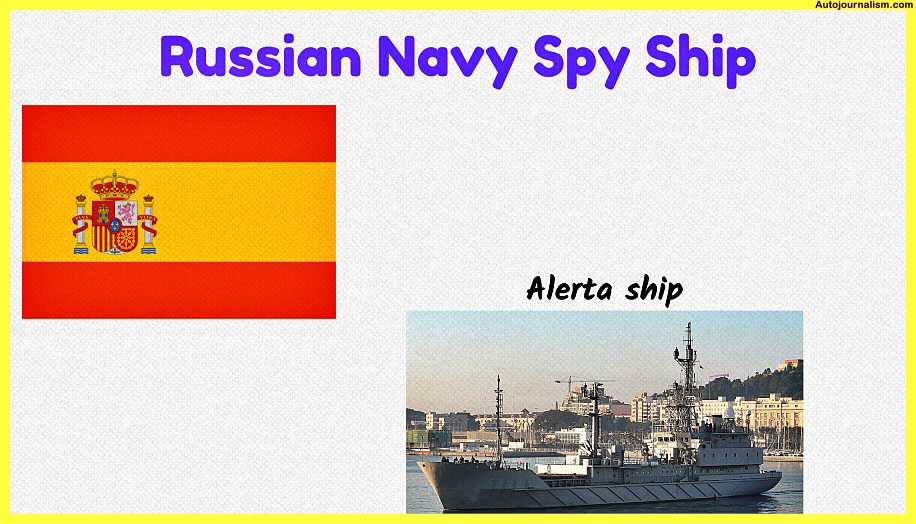
- Country:
 Spain
Spain - Class, [Type]: Darss, [AGI].
- Builder: Neptunwerft, Rostock, Germany.
- Launch date: 27 February 1982.
- Commission date: 12 June 1992.
- Displacement ( tons ): 1.800 standard, 2.292 full load.
- Dimensions ( metres ): 76,3 x 12,1 x 4,2
- Main machinery: 1 x Kolomna Type 40-DM diesel ( 2.200 cv ).
- Speed ( knots ): 12.
- Range ( miles ): 1.000 at 12 knots.
- Complement: 60.
- Guns: It can operate up to 3 x 25mm/70 double mountings.
- Radar: Navigation: I band.
- Callsign: EBQD (



 )
)
Former Jasmund. Was to have transferred to Ecuador in 1991 but the sale was canceled. Last of a batch of ships known as the DARSS class. This ship belonged to the former GDR, where it first was used for transport duties ( until 1988 ), and later converted to AGI, performing its duties until 1990. On 21st December 1992 arrived in the Canary Islands where it went through a series of updates and conversions for its future use by the Spanish Navy. The work was done at ASTICAN´s facilities, at Puerto de la Luz. On 15th July 1993, it was commissioned as an ELINT platform for the Spanish Navy, and releaved patrol ship Alsedo ( who was performing those duties at the time ), fifteen days after his decommissioning. Supposedly most of its equipment and instruments are of soviet origin. It has a Saturn 3S satellite communications antenna.
#12. Swedish Navy
1. HSwMS Orion Spy Ship
HSwMS Orion (A201) is a signals intelligence gathering vessel of the Swedish Navy. HSwMS Orion was launched in 1984. She was built with extensive support from the United States National Security Agency. In November 1985, HSwMS Orion was rammed by a Soviet minesweeper after she got too close to a Soviet naval exercise. In 1998 Orion received a false bomb threat, which was widely covered in the Swedish newspapers. The ship is operated by Swedish Navy officers and sailors, as well as personnel from the National Defence Radio Establishment (FRA). HSwMS Orion belongs to the 1st Submarine division. Orion shares a hull design with the Fiskeriverkets vessel Argos, an official fishing control vessel.
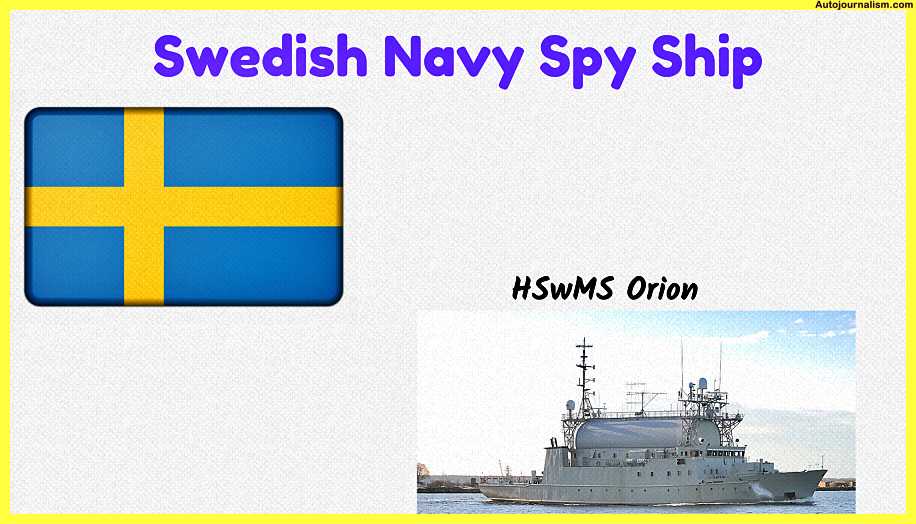
| History | |
|---|---|
| Name | Orion |
| Builder | Kockums |
| Launched | June 1984 |
| Homeport | Karlskrona |
| Identification |
|
| Status | In active service |
| General characteristics | |
| Type | Signals intelligence gathering vessel |
| Displacement | 1,400 tons |
| Length | 61.2 m (200 ft 9 in) |
| Beam | 11.7 m (38 ft 5 in) |
| Draught | 3.8 m (12 ft 6 in) |
| Propulsion | 2 x Hedemora diesels |
| Speed | 12 knots (22 km/h; 14 mph) |
| Complement | 26 |
2. HSwMS Carlskrona Spy Ship
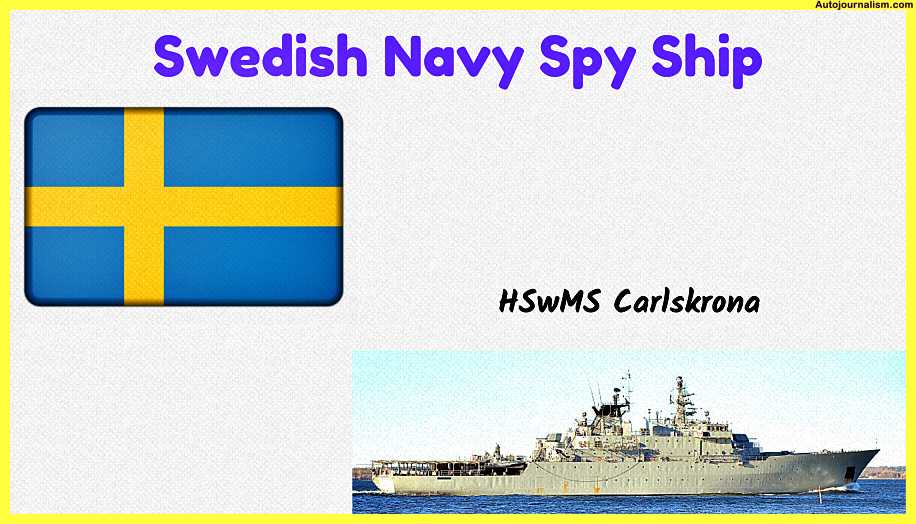
| History | |
|---|---|
| Name | Carlskrona |
| Builder | Karlskronavarvet, Karlskrona |
| Launched | 28 June 1980 |
| Commissioned | 11 January 1982 |
| Identification |
|
| Status | In service |
| Badge |
 |
| General characteristics | |
| Type | Patrol vessel |
| Displacement | 3,150 tonnes (3,100 long tons) |
| Length | 105.7 m (346 ft 9 in) |
| Beam | 15.2 m (49 ft 10 in) |
| Draft | 4.7 m (15 ft 5 in) |
| Speed | 20 knots (37 km/h; 23 mph) |
| Complement |
|
| Sensors and processing systems |
2 x fire control radars with IR/TV sights |
| Armament | 2 x 40 mm guns |
| Aircraft carried | 1 x AW109LUH (HKP15B) |
| Aviation facilities | 1 helipad |
#13. United States Navy
1. USS Oxford Spy Ship
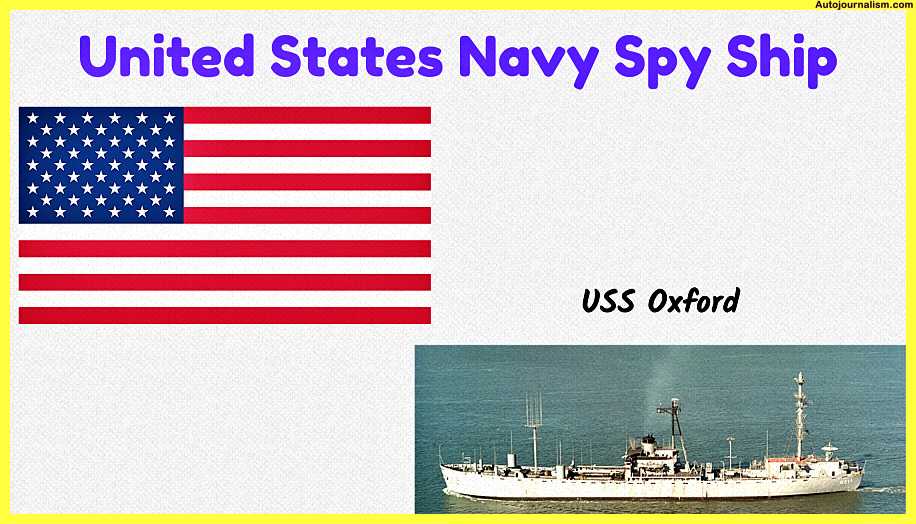
| History | |
|---|---|
| Name | USS Oxford |
| Namesake | American towns, cities, and counties named Oxford |
| Ordered |
|
| Builder | New England Shipbuilding Corporation |
| Laid down | 23 June 1945 |
| Launched |
|
| Commissioned | 8 July 1961 |
| Decommissioned | 19 December 1969 |
| Stricken | 14 January 1970 |
| Motto | “Strength Freedom Security” |
| Fate | Scrapped, June 1970 |
| Badge |
 |
| General characteristics | |
| Displacement | 11,365 (f.) |
| Length | 441 ft (134 m) |
| Beam | 59 ft (18 m) |
| Draft | 22 ft (6.7 m) |
| Propulsion |
2,500 shp (1,864 kW)
|
| Speed | 11 knots |
| Complement | 254 |
2. USS Georgetown Spy Ship

| History | |
|---|---|
| Name |
|
| Namesake | Robert W. Hart |
| Builder | New England Shipbuilding Corporation |
| Laid down | 4 May 1945, as SS Robert W. Hart |
| Launched | 10 July 1945 |
| Sponsored by | Mrs. Fred W. Woolsey |
| Acquired | 10 August 1962 |
| Commissioned | 9 November 1963 |
| Decommissioned | 19 December 1969 |
| Renamed | USS Georgetown (AG-165), 6 March 1963 |
| Reclassified | AGTR-2, 1 April 1964 |
| Motto | “Progress Through Research” |
| Fate | Scrapped, 1971 |
| Badge |
 |
| General characteristics | |
| Class and type | An oxford-class technical research ship |
| Type | Z-EC2-S-C5 |
| Displacement |
|
| Length | 441 ft 6 in (134.6 m) |
| Beam | 56 ft 11 in (17.3 m) |
| Draft | 22 ft 9 in (6.9 m) |
| Propulsion |
2,500 shp (1,864 kW)
|
| Speed | 11 knots (20 km/h; 13 mph) |
| Complement | 213 |
| Armament | 4 × 0.5 in (12.7 mm) machine guns |
3. USS Jamestown Spy Ship

| History | |
|---|---|
| Name | USS Jamestown |
| Namesake | Jamestown, Virginia |
| Launched | 1844 |
| Commissioned | 12 December 1844 |
| Decommissioned | 11 May 1854 |
| Fate | Became a Marine Hospital, destroyed in a fire on 3 January 1913 |
| Recommissioned | 22 February 1855 |
| Decommissioned | 2 June 1857 |
| Recommissioned | 16 December 1857 |
| Decommissioned | 14 February 1860 |
| Recommissioned | 5 June 1861 |
| Decommissioned | 17 September 1865 |
| Recommissioned | 3 September 1866 |
| Decommissioned | 13 August 1868 |
| Recommissioned | 25 January 1869 |
| Decommissioned | 7 October 1871 |
| Recommissioned | 16 March 1876 |
| Decommissioned | 3 March 1879 |
| Recommissioned | 8 May 1879 |
| Decommissioned | 21 September 1881 |
| Recommissioned | 14 February 1882 |
| Decommissioned | 31 August 1888 |
| Recommissioned | 13 April 1889 |
| Decommissioned | 6 September 1892 |
| Fate |
|
| General characteristics | |
| Type | Sloop |
| Displacement | 1,150 long tons (1,168 t) |
| Length | 163 ft 6 in (49.83 m) |
| Beam | 32 ft 2 in (9.80 m) |
| Depth | 17 ft 3 in (5.26 m) |
| Complement | 186 officers and sailors |
| Armament |
|
4. USS Belmont Spy Ship

| History | |
|---|---|
| Name | SS Iran Victory |
| Namesake | Iran |
| Owner | War Shipping Administration |
| Operator | Pacific-Atlantic Steamship Company |
| Port of registry | |
| Builder | Oregon Shipbuilding Company, Portland, Oregon |
| Yard number | 1010 |
| Laid down | 25 January 1944 |
| Launched | 24 March 1944 |
| Completed | 4 May 1944 |
| Fate | Transferred to U.S. Navy in February 1963,
as USS Belmont |
| Name | USS Belmont |
| Acquired | February 1963 |
| Commissioned | 2 November 1964 |
| Decommissioned | 16 January 1970 |
| Stricken | 16 January 1970 |
| Homeport | Norfolk, Virginia |
| Identification | AGTR-4 |
| Fate | Scrapped, 24 June 1970 |
| Badge |
 |
| General characteristics | |
| Class and type | VC2-S-AP3 Victory ship |
| Tonnage |
|
| Displacement | 15,200 tons |
| Length | 455 ft (139 m) |
| Beam | 62 ft (19 m) |
| Draught | 28 ft (8.5 m) |
| Installed power | 8,500 shp (6,300 kW) |
| Propulsion | HP & LP turbines geared to a single 20.5-foot (6.2 m) propeller |
| Speed | 16.5 knots (30.6 km/h; 19.0 mph) |
| Boats & landing craft carried |
4 lifeboats |
| Complement |
and 28 US Naval Armed Guards as Victory ship
|
| Armament |
|
5. USS Liberty Spy Ship

| History | |
|---|---|
| Name | SS Simmons Victory |
| Namesake | Simmons College in Boston |
| Owner | War Shipping Administration |
| Operator | Coastwise – Pacific Far East Line (during WW II only) |
| Builder | Oregon Shipbuilding Corp. |
| Laid down | 23 February 1945 |
| Launched | 6 April 1945 |
| Completed | 4 May 1945 |
| Fate | Transferred to US Navy in 1963 |
| Name | USS Liberty |
| Namesake | Localities named “Liberty” in ten US states |
| Acquired | 25 March 1963 |
| Commissioned | 30 December 1964 |
| Decommissioned | 1 June 1968 |
| Out of service | June 1967 |
| Stricken | 1 June 1970 |
| Homeport | Norfolk, Virginia |
| Fate | Damaged beyond economical repair by an Israeli
attack in June 1967; sold for scrap in 1973 |
| Badge |
 |
| General characteristics | |
| Displacement | 7725 tons (light displacement) |
| Length | 139 m (456 ft) |
| Beam | 18.9 m (62 ft) |
| Draft | 7 m (23 ft) |
| Propulsion | Westinghouse steam turbines, single shaft,
8500 horsepower (6.3 MW) |
| Speed | 17.5 knots (32.4 km/h) maximum sustained,
21 knots emergency |
| Range | 12,500 nmi (23,200 km; 14,400 mi)
at 12 knots (22 km/h; 14 mph) |
| Complement |
as Victory ship[citation needed]
|
| Armament |
|
| Aircraft carried | none |
6. USS Banner Spy Ship
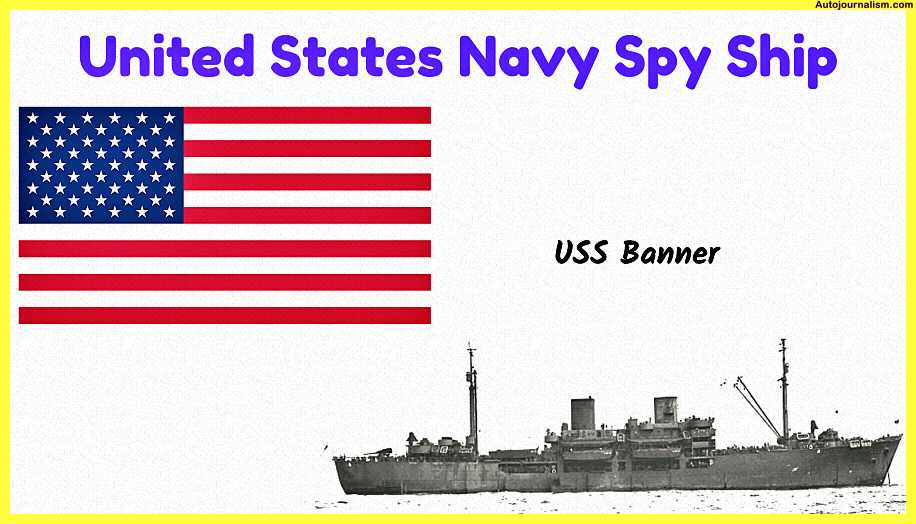
| History | |
|---|---|
| Name |
|
| Builder | Kewaunee Shipbuilding and Engineering |
| Laid down | 1944 |
| Commissioned | 24 November 1952 |
| Decommissioned | 14 November 1969 |
| Fate | Scrapped |
| General characteristics | |
| Displacement | 550 tons light, 895 tons full, 345 tons dead |
| Length | 177 ft (54 m) |
| Beam | 32 ft (9.8 m) |
| Draft | 9 ft (2.7 m) |
| Propulsion | twin diesel |
| Speed | 12.7 knots (23.5 km/h) |
| Complement | 6 officers, 70 men |
| Armament | 2 × M2 Browning .50-caliber machine guns |
7. USS Pueblo Spy Ship
USS Pueblo (AGER-2) is a Banner-class environmental research ship, attached to Navy intelligence as a spy ship, which was attacked and captured by North Korean forces on 23 January 1968, in what was later known as the “Pueblo incident” or alternatively, as the “Pueblo crisis”.
The seizure of the U.S. Navy ship and her 83 crew members, one of whom was killed in the attack, came less than a week after President Lyndon B. Johnson’s State of the Union address to the United States Congress, a week before the start of the Tet Offensive in South Vietnam during the Vietnam War and three days after 31 men of North Korea’s KPA Unit 124 had crossed the Korean Demilitarized Zone (DMZ) and killed 26 South Koreans in an attempt to attack the South Korean Blue House (executive mansion) in the capital Seoul. The taking of Pueblo and the abuse and torture of her crew during the subsequent eleven months became a major Cold War incident, raising tensions between western and eastern powers.

| History | |
|---|---|
| Name | Pueblo |
| Namesake | Pueblo, Colorado and Pueblo County, Colorado. |
| Builder | Kewaunee Shipbuilding and Engineering |
| Laid down | 1944 |
| Launched | 16 April 1944 |
| Commissioned | 7 April 1945 |
| In service | 1945 |
| Reclassified | 18 June 1966, AKL-44 13 May 1967, AGER-2 |
| Honors and awards |
|
| Captured | 23 January 1968 |
| Fate | Captured by North Korea |
| Status | Active, in commission (to prevent seizure,
currently held by North Korea as a museum ship) |
| Badge |
 |
| General characteristics | |
| Class and type |
|
| Type | (As-built) Light Cargo Ship; (As converted) Intel-Gathering Vessel |
| Tonnage | 345 tons dwt |
| Displacement | 550 tons light, 895 tons full |
| Length | 177 ft (54 m) |
| Beam | 32 ft (9.8 m) |
| Draft | 9 ft (2.7 m) |
| Propulsion | Two 500hp GM Cleveland Division 6-278A 6-cyl V6 Diesel engines |
| Speed | 12.7 knots (23.5 km/h; 14.6 mph) |
| Complement | 6 officers, 70 men |
| Armament | 2 × M2 Browning .50 cal. (12.7×99mm) machine guns |
8. USS Palm Beach Spy Ship

| History | |
|---|---|
| U.S. Army service: | |
| Name |
|
| Builder | Higgins Industries, New Orleans, Louisiana |
| In service | December 1944 |
| Out of service | Placed in reserve on 17 February 1956 |
| U.S. Navy service: | |
| Name | USS Palm Beach (AGER-3) |
| Acquired | 18 June 1966 |
| Identification | IMO number: 8836089 |
| Fate | Sunk as Diving Wreck |
| General characteristics | |
| Type | Design 427 coastal freighter |
| Displacement | 693 long tons (704 t) |
| Length | 180 ft (55 m) |
| Beam | 33 ft (10 m) |
| Draft | 10 ft (3.0 m) |
| Propulsion | 2 500hp GM Cleveland Division
6-278A 6 cyl V6 Diesel engines, twin screws |
| Speed | 13 knots (24 km/h; 15 mph) |
| Complement | 42 as AKL, 83 as AGER |
| Armament | Two M2HB 0.5 in (12.7 mm) HMGs |
9. USNS Private Jose F. Valdez Spy Ship

| History | |
|---|---|
| Name |
|
| Namesake |
|
| Ordered | as type (C1-M-AV1) hull, MC hull 2245 |
| Builder | Walter Butler Shipbuilders, Duluth, Minnesota |
| Laid down | 22 April 1944 |
| Launched | 27 October 1944 |
| Acquired | 5 July 1945 |
| Commissioned | 12 July 1945 as USAT Private Jose F. Valdez |
| Out of service | 2 September 1950 |
| Fate | Transferred to the US Navy |
| Name | Private Jose F. Valdez |
| Acquired | 2 September 1950 |
| In service | 2 September 1950 |
| Out of service | 22 December 1959 |
| Reclassified | Transport ship |
| Identification | Hull symbol: T-APc-119 |
| Notes | Returned to Reserve Fleet |
| Acquired | 29 August 1961 |
| In service | 29 August 1961 |
| Out of service | 7 November 1969 |
| Reclassified | Technical research ship |
| Stricken | 15 August 1976 |
| Homeport | Brooklyn, New York |
| Identification | Hull symbol: T-AG-1169 |
| Fate | Sold for scrap, 27 July 1977 |
| General characteristics | |
| Type | C1-M-AV1 |
| Displacement | 6,070 long tons (6,167 t) |
| Length | 388 ft 8 in (118.47 m) |
| Beam | 50 ft (15 m) |
| Draft | 18 ft (5.5 m) |
| Installed power |
|
| Propulsion | 1 × shaft |
| Speed | 11.5 knots (21.3 km/h; 13.2 mph) |
| Complement | Approximately 55 civilians
and 100 Navy personnel (USNS) |
| Armament | 1 × 3 inches (76 mm)/50 caliber gun |
10. USNS James E. Robinson Spy Ship
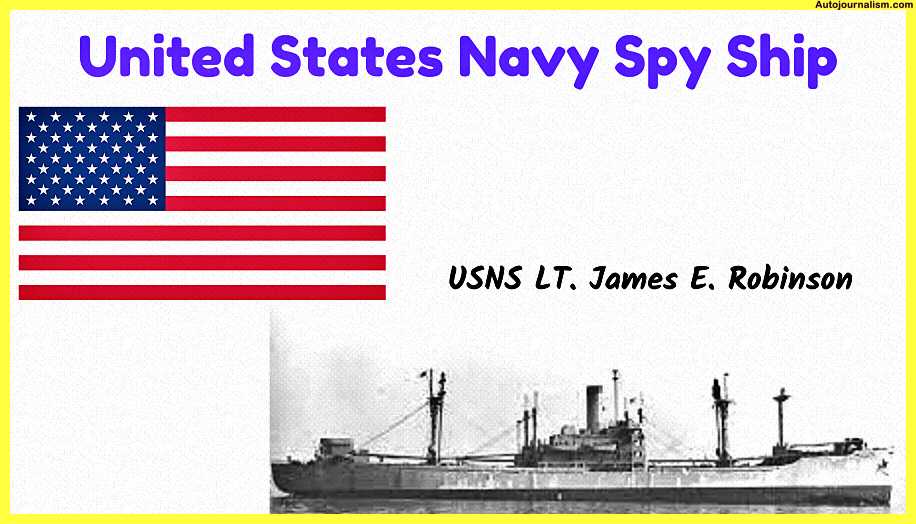
| History | |
|---|---|
| Name | Czechoslovakia Victory |
| Namesake | Czechoslovakia |
| Owner | War Shipping Administration |
| Operator | American-Hawaiian SS Compnay |
| Ordered | as type (VC2-S-AP2) hull, MCV hull 86 |
| Awarded | awarded the Medal of Honor during World War II |
| Builder | Oregon Shipbuilding Corporation, Portland, Oregon |
| Laid down | 25 November 1943, as SS Czechoslovakia Victory |
| Launched | 20 January 1944 |
| Christened | Miss Barbara Vickery |
| Completed | March 11, 1944 |
| Honors and awards |
one battle star for World War II service |
| Fate | Transferred to US Navy in 1946 |
| History | |
| Name | USNS Lt. James E. Robinson |
| Namesake | James E. Robinson, Jr. |
| Operator | US Navy |
| Commissioned | 3 May 1948 as USAT Lt. James E. Robinson |
| In service | 1 March 1950 as Aircraft Transport USNS Lt. James E. Robinson (T-AKV-3) |
| Reclassified |
USNS Lt. James E. Robinson (T-AG-170), a cable transport ship
|
| Stricken | 16 January 1981 |
| Identification |
|
| Fate | sold for scrapping, 26 May 1983, to Andy Exports, Inc. |
| General characteristics | |
| Class and type | VC2-S-AP3 Victory ship then rebuilt in 1946 to Lt. James E. Robinson-class cargo ship |
| Displacement |
|
| Length | 455 ft (139 m) |
| Beam | 62 ft (19 m) |
| Draft | 29 ft 2 in (8.89 m) |
| Installed power | 8,500 shp (6,300 kW) |
| Propulsion |
|
| Speed | 15.5 knots (28.7 km/h; 17.8 mph) |
| Complement |
|
| Armament |
|
11. USNS Joseph E. Muller Spy Ship
| History | |
|---|---|
| Name |
|
| Namesake | Joseph E. Muller, who was awarded the Medal of Honor |
| Builder | Southeastern Shipbuilding Corporation, Savannah, Georgia |
| Laid down | December 1944, as M/V Check Knot,
type (C1-M-AV1) hull, MC hull 2485 |
| Launched | 17 February 1945 |
| Sponsored by | Mrs. D. R. Williams |
| In service |
|
| Out of service | 1969 |
| Refit | as a Miscellaneous auxiliary (technical research ship)
at Maryland Shipbuilding and Dry Dock Company, Baltimore, Maryland, in October 1962 |
| Stricken | 25 October 1957 and on 16 September 1969 |
| Identification | U.S. Official Number: 247488 |
| Fate | Transferred to MARAD,
13 November 1969; sold on 3 October 1972 |
| General characteristics | |
| Type | C1-M-AV1 |
| Tonnage | 3,805 GRT |
| Displacement | 6,090 tons |
| Length | 338 feet 9 inches (103.3 m) |
| Beam | 50 feet 4 inches (15.3 m) |
| Draft | 21 feet (6.4 m) |
| Propulsion | diesel, single propeller |
| Speed | 11.5 knots |
| Troops | 101[citation needed] |
| Complement | 107 officers and enlisted |
| Armament | none |
12. USS Sphinx Spy Ship
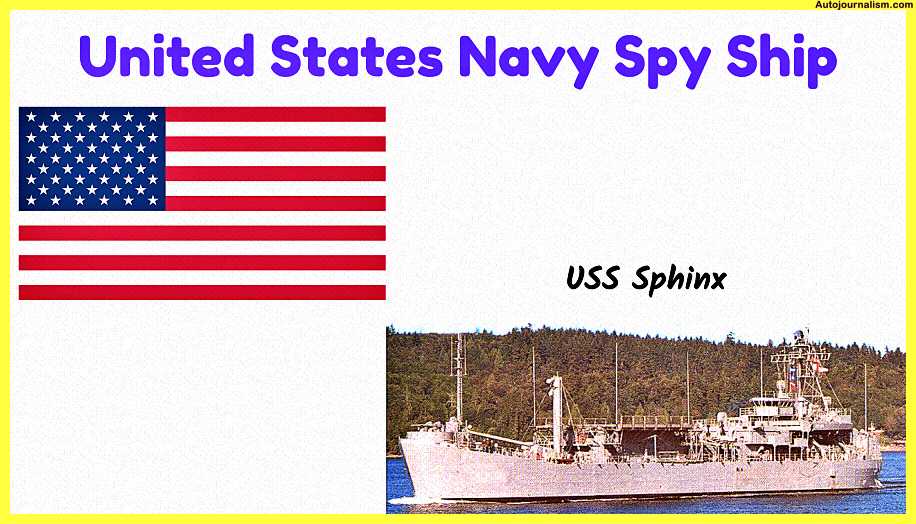
| History | |
|---|---|
| Name |
|
| Namesake | Sphinx |
| Builder | Bethlehem Shipbuilding Corporation |
| Laid down | 20 October 1944 |
| Launched | 7 March 1945 |
| Commissioned |
|
| Decommissioned | 26 May 1947 |
| Recommissioned | 3 November 1950 |
| Decommissioned | 31 January 1956 |
| Recommissioned | 16 December 1967 |
| Decommissioned | 30 September 1971 |
| Stricken | 16 April 1977 |
| Acquired | 1985 |
| Recommissioned | 26 July 1985 |
| Decommissioned | 16 June 1989 |
| Stricken | 2 December 2002 |
| Identification |
|
| Honors and awards |
|
| Fate | Towed for scrapping, 1 December 2007 |
| General characteristics | |
| Class and type |
|
| Displacement |
|
| Length | 328 ft (100 m) oa |
| Beam | 50 ft (15 m) |
| Draft | 11 ft 2 in (3.40 m) |
| Installed power |
|
| Propulsion |
|
| Speed | 11.6 kn (21.5 km/h; 13.3 mph) |
| Complement | 21 officers, 232 enlisted men |
| Armament |
|
| Service record | |
| Part of: | Joint Task Force 1 (World War II) |
| Operations: |
|
| Awards: |
|
Read also:



